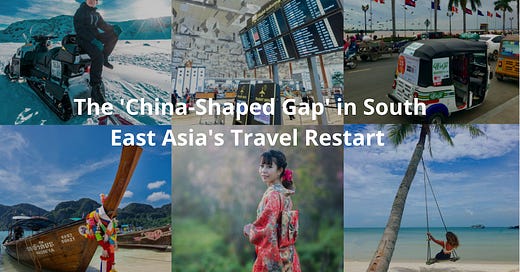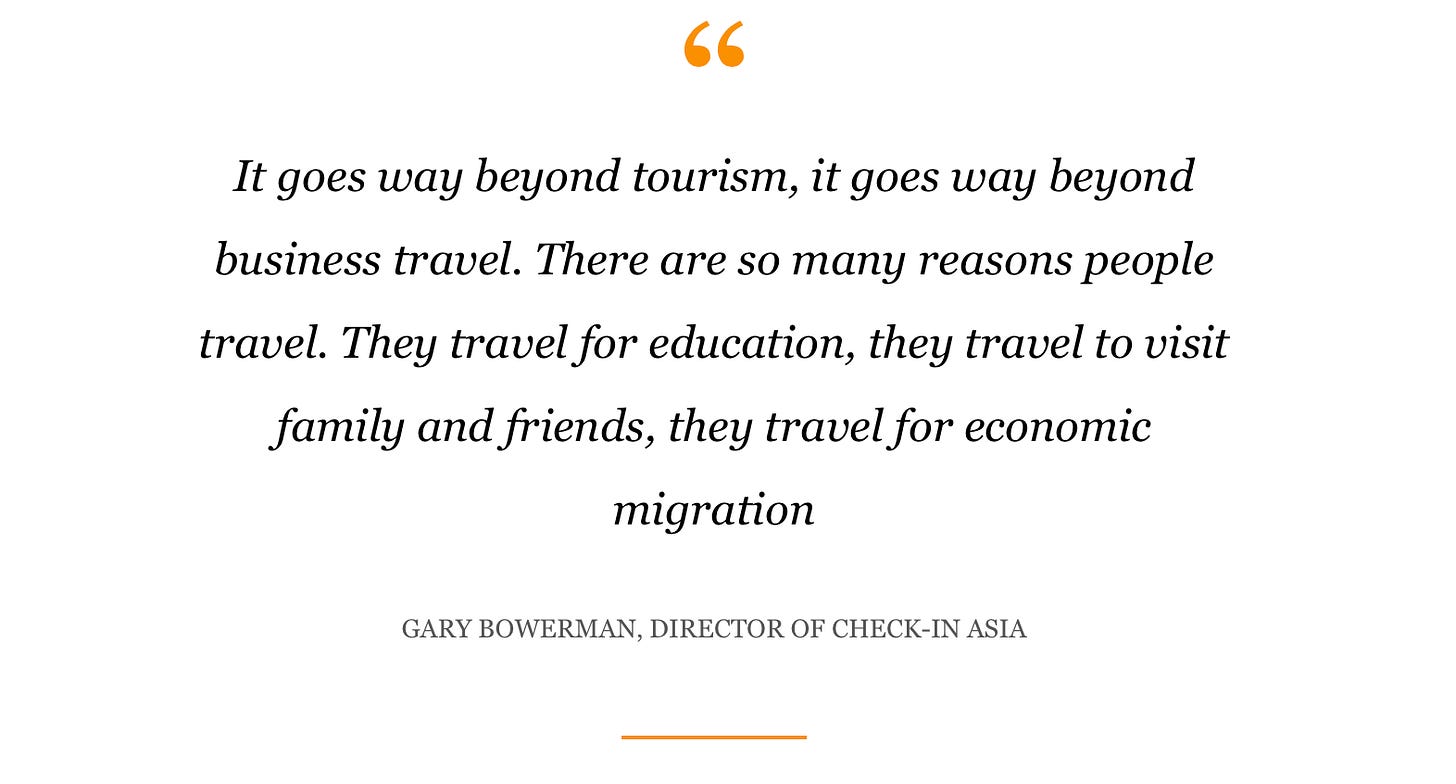Issue #64 - The 'China-Shaped Gap' in South East Asia's Travel Restart
Nations must confront a third year without high-spending Chinese visitors.
Hello. Welcome to issue 64 of Asia Travel Re:Set…
10 months.
It’s been a long time since I looked at the Chinese outbound market. The last occasion was Issue 26, When Will Chinese Outbound Travellers Return?
Still, South East Asia is asking the same question. No answer is forthcoming.
The Chinese government’s Zero Tolerance COVID-19 strategy continues to push further back the return of Chinese tourists.
As countries such as Singapore, Thailand, Cambodia & Vietnam progress their travel restarts, a China-shaped gap is evident in their strategy planning.
A realisation is crystallising that this could endure for some time to come.
Thanks for being on board,
Gary
The Sunday Itinerary
- This Week’s Top 5
Updates from Japan, the Philippines, Indonesia, Brunei, Malaysia
- The ‘China-Shaped Gap’ in South East Asia’s Travel Restart
Nations must confront a third year without high-spending Chinese visitors
This Week’s Top 5
Updates from Japan, the Philippines, Indonesia, Brunei, Malaysia
Inching forward in Japan, which increases its daily visitor cap for vaccinated “businesspeople, students and technical interns” to 5,000 on 26 November.
Airport gates ease open in the Philippines, where vaccinated visitors from 44 Green List countries will be able to enter quarantine-free.
Curbing domestic travel in Indonesia, where the government will apply “level 3 restrictions nationwide” for the year-end travel period to head off a ‘third wave’.
Brunei edges towards reopening. South East Asia's smallest nation says it "will open its borders for travel once 80% of the population has been vaccinated."
Airline fleet upgrade in Malaysia, where the national carrier is finalising an aircraft deal unexpectedly made by previous Prime Minister Najib Razak.
“IN THE NEWS”
This week, UBS Thailand invited me to present to its Annual Investor Forum on the outlook for travel and tourism in Thailand. The 30-minute presentation was followed by a 30-minute Q&A - and some of the most astute questions I’ve been asked all year.
Many thanks to John Power, Asia-Pacific Business Editor at Al Jazeera, for including some of my comments in his detailed, and very readable, article Asia holds tight on borders, casting cloud over COVID-hit travel
The ‘China-Shaped Gap’ in South East Asia’s Travel Restart
Nations must confront a third year without high-spending Chinese visitors
“The world’s tourism economy is being reconfigured and new source markets are being courted. The richest pick is China because it is sending more travellers to spend more money in more destinations than any other country.
Will the inexorable rise of the Chinese traveller continue? China has always been, and remains, a difficult country to predict… But what the revolutionary changes over the last decade have shown is that the assimilation of domestic, inbound and outbound travel has created a powerful economic structure.”
I wrote those words in early 2014 for my book The New Chinese Traveler: Business Opportunities from the Chinese Travel Revolution. The backbone of those paragraphs remains intact. Chinese tourism shook the world for the entire 2010s. But China’s prolonged COVID-era isolation means its outbound travel ecosystem is dormant.
Consequently, South East Asian governments and tourism boards are confronting a third consecutive Lunar New Year without Chinese visitors.
They are also starting to accept that tourism planning for 2022 must target alternative markets.
The Region’s Travel Superpower
Throughout the 2010s, China’s travel influence burgeoned in South East Asia.
In 2010, China supplied 5.4 million visitors across the region.
By 2015, it was ASEAN’s number 1 inbound market (overtaking Singapore) for the first time, with 18.6 million arrivals.
In 2019, China contributed 32.3 million of the 143.5 million visitors to the 10 countries of ASEAN. Some distance behind in 2nd spot was Singapore with 13.8 million. South Korea was the only other country to supply more than 10 million visitors.
Even in travel-curtailed 2020, China provided 4 million of ASEAN’s 26.1 million visitors.
Restarting Travel Without China
A cursory glance at the above graphic - which we discussed on the OAG Webinar: South East Asia - Rebuilding International Growth - shows that for South East Asia’s two ‘most open’ countries, Cambodia (KH) and Thailand (TH), 31.5% and 23.4%, respectively, of international air passengers in November 2019 took off in China.
Those are eye-watering figures.
Thailand, which was South East Asia’s most visited country in 2019 - attracting 39.92 million arrivals - will feel the Chinese absence keenly as it rebuilds its shattered visitor economy. It welcomed 10.99 million Chinese arrivals in 2019.
This week, Thailand published inbound data for the first two weeks of its Test & Go reopening (see below). From 1-14 November, around 50,000 visitors were recorded, with the top 10 markets including just 2 Asia Pacific nations, Japan and South Korea.
China is, of course, one of the 63 countries and territories listed by Thailand as eligible for quarantine-free entry.

Bali officially reopened to vaccinated inbound travellers in mid-October. Indonesia’s government published a list of 19 eligible visitor countries. China is included.
This week, the Philippines said its Phase 1 reopening will welcome vaccinated visitors from 44 ‘Green List’ countries and territories. China is included.
Cambodia has taken a different approach, stating it is open quarantine-free to vaccinated visitors from everywhere. In 2019, China provided 2.4 million of the 6.62 million arrivals.
Vietnam’s three-phase reopening began this month with charter flights to selected provinces. “People travelling by air will be from places that have controlled the pandemic like those in Northeastern Asia, Europe, the US and Australia,” said local media. China would clearly fall under that loose categorisation.
Singapore garners its reopening media attention from 21 Vaccinated Travel Lanes, for which China is not included. However, it began reconnecting with Chinese visitors in June 2020, when it launched a “Fast Track for Essential Travellers” from 6 provinces.
Entry rules have changed occasionally since for specific Chinese provinces affected by outbreaks. On 9 September 2021, China - plus Hong Kong, Macao and Taiwan - were afforded Category 1 status. At the time, this was the simplest form of entry to Singapore, requiring a test on arrival.
Malaysia has yet to confirm its reopening, but a ‘pilot travel bubble’ on the island of Langkawi began this week. Pre-pandemic, Guangzhou, China, was one of 3 international airports with direct flights to Langkawi, alongside Singapore and Doha.
The ‘Quality Tourism’ Question
High-quality, or high-yield or high-value, tourism has been a buzz topic in recent months. Governments including Thailand, Indonesia, Malaysia and Cambodia have used various iterations to claim they want to attract long-stay guests who spend more.
This is a short-term smoke screen, and governments know it.
At a strike, such a policy would wipe out much of the intra-Asian travel market that expanded so quickly over the last decade - of which China is a vital component.
The intra-Asian market fuelled South East Asia’s visitor economy, and will do again.
Eight of the region’s Top 10 visitor markets in 2019 were Asian countries, plus Russia and the US. Fifteen of the Top 20 were Asia Pacific nations (including Australia).
Annual paid leave is a central issue, as it remains at a low level in much of Asia. Travellers, therefore, tend to stitch their trips around long weekends and public holidays - and the average length of stay is quite low, usually 3-5 days.
Are governments across Asia going to turn away this year-round travel trade in favour of long-stay, long-haul travellers whose impact is largely seasonal?
Of course they aren’t.
BUT, the intra-Asian market will take time to recover, hence the ‘quality’ posturing.
Rebuilding flight routes and passenger traffic from China - where international flight capacity has slumped to around 1% of the total air market - remains the priority.
The Million Dollar Question
When will China reopen its borders? Or, at least, when will Chinese travellers start travelling outbound again?
We have spent much of the pandemic reading about the unleashing of “revenge travel” once China’s airport gates reopen.
The Chinese government’s Zero Tolerance strategy is stoppering the bottleneck. Outbound demand does, clearly, exist.
Even without the much-cited Winter Olympics in Beijing, which take place in February 2022, China would almost certainly not have reopened this winter.
While it has a high vaccination rate, concerns about the waning effect of Chinese vaccines likely mean it will target booster shots for at least 80% of its population before countenancing international travel.
China’s booster shot target might not be reached until the second half of 2021.
This would coincide with the planning for the Communist Party of China’s National Congress - which is expected to confirm President Xi Jinping’s 3rd term in office.
A central part of the Congress narrative will be keeping the world’s most populace nation safe from a deadly virus that has killed 5.15 million people worldwide. This global death toll includes 465,000 in India, 771,000 in the US and 144,000 in Indonesia - the world’s 2nd, 3rd and 4th-most populace nations, respectively.
Should the party congress take place in November 2022, that would mark the onset of another winter - and, most likely, yet more global pandemic uncertainty.
Will the now-starting northern hemisphere winter bring a new variant before then?
All this tosses a curveball that China might not reopen its borders until Spring 2023.
Having studied Chinese in Beijing and been a restaurant critic in Shanghai, Jarrett Wrisley worked on a TV shoot in Chengdu with Anthony Bourdain. Shortly after, he moved to Bangkok and opened his own restaurant. Soul Food Mahanakorn built a global following and became part of the city’s dynamic dining scene. At the height of Soul Food’s powers, COVID-19 intervened. On this week’s The South East Asia Travel Show, Jarrett discusses the pandemic restrictions that suffocated Bangkok’s restaurant scene, his decision to close up and leave - and what comes next.
Listen here:
🎧 Website
🎧 Spotify
🎧 Apple
Or wherever you grab your pods!
And, that’s a wrap for Issue 64.
Next week Dr Jaeyeon Choe is back for the November Asia Pacific Travel & Tourism Report.
Until next Sunday, find me on Twitter, LinkedIn, the Asia Travel Re:Set website and The South East Asia Travel Show.
Have a great week,
Gary








